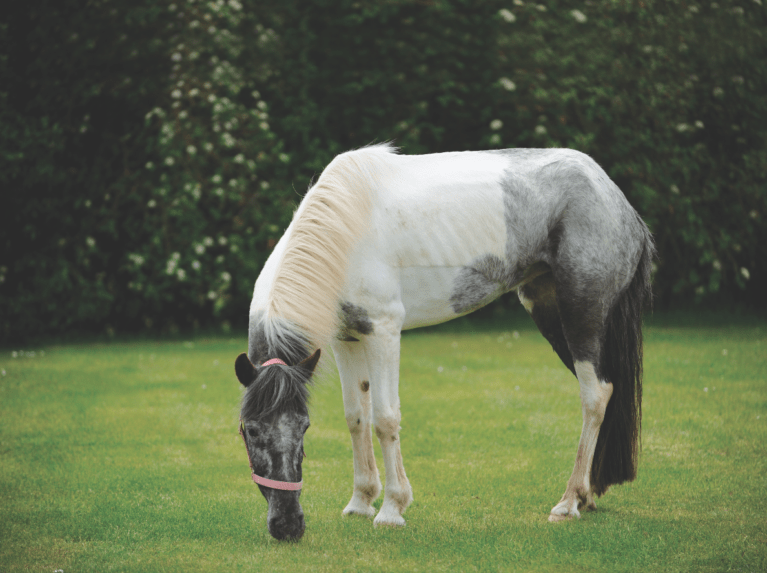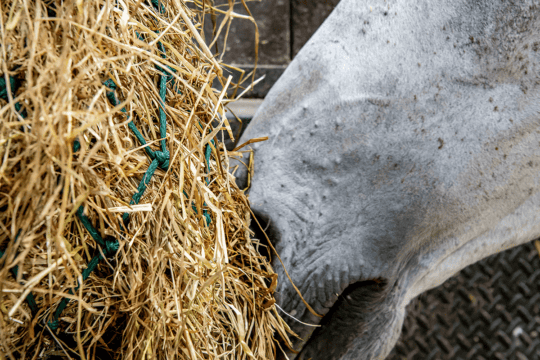With a death rate of more than 85%, equine grass sickness (EGS) is a serious, debilitating disease that affects horses, ponies and donkeys.

With a death rate of more than 85%, equine grass sickness (EGS) is a serious, debilitating disease that affects horses, ponies and donkeys. It causes severe, extensive damage to nerves, mostly the ones that control involuntary functions, and the gastrointestinal tract is particularly affected.
EGS was first described in eastern Scotland in the early 1900s and Britain has the highest incidence of the disease worldwide, with equines in Scotland and northeast England being particularly susceptible. There is limited accurate information about how common EGS is but, on average, approximately 140 cases are reported to the nationwide Grass Sickness Surveillance Scheme each year.
What causes Equine Grass Sickness (EGS)?
Almost all cases of EGS occur in horses with access to grazing. Scientific evidence suggests that the disease may be caused by the bacterium Clostridium botulinum type C, which is commonly found in soil and can produce neurotoxins that horses are particularly sensitive to. The disease is thought to occur when a combination of several risk factors triggers C botulinum that’s present in the horse’s intestinal tract to produce neurotoxins.
Decades of research have identified many risk factors associated with EGS, including…
- access to grazing – this is the main risk factor for EGS, with only a couple of isolated reports of the disease occurring in stabled horses
- EGS having occurred on a premises previously – it’s considerably more likely to recur on premises where there has been a previous case
- the time of year – 60% of all cases occur between April and June, particularly during periods of cold, dry weather
- recent movement to a new premises or pasture – exposure to new grazing is associated with an increased risk of EGS
- age – young adults aged between two and seven years are at greatest risk
- breed – it’s been suggested that native Scottish breeds may be more susceptible
- pasture disturbance – studies have identified increased risk where there is a history of pasture disturbance, presumably due to increasing the chance of soil ingestion
What to look out for
The disease can occur in acute, subacute and chronic forms, reflecting the severity and the duration of clinical signs. The clinical signs of acute EGS are severe, appear suddenly and may include…
- depression
- colic
- excessive salivation
- difficulty swallowing
- an inability to eat
Subacute cases show signs that are similar to acute cases, but less severe. Cases of acute and subacute EGS are invariably fatal, with acute cases dying or requiring euthanasia within 48 hours.
Horses surviving beyond seven days are classed as having the chronic form of EGS. Approximately a third of EGS cases present with the chronic form, which has a more gradual onset, and the signs include…
- profound weight loss
- a ‘tucked up’ abdominal appearance
- an abnormal stance
While recovery may be possible in cases of chronic EGS, the level of nursing they require is intensive, and treatment can be prolonged and expensive.
One clinical sign that may be observed in all three forms of EGS is droopiness of the upper eyelids, giving the horse a sedated appearance. This sign is called ptosis. If you notice any of these signs in your horse, you should call your vet without delay.
Diagnosing EGS
Unfortunately, the most reliable way to diagnose EGS is by conducting a thorough post mortem examination, but in many cases a diagnosis can be made based on the clinical signs, case history and ruling out other possible diagnoses.
It’s possible to reach a definitive diagnosis in a live horse, but this involves taking biopsies of the gastrointestinal tract during exploratory abdominal surgery with the horse under general anaesthetic, then examining the samples under a microscope. Abdominal surgery can be useful because it helps to rule out surgical colic, which can show similar signs, but it’s expensive and usually requires referral to an equine hospital with surgical facilities.
A non-invasive test that’s commonly used to help diagnose EGS involves applying a small amount of
a drug called phenylephrine to one eye then, after a short period, the angles of both upper eyelashes are compared. This drug can temporarily reverse the droopy upper eyelid (ptosis) in EGS cases, but as horses without EGS can also show a positive result, it’s important to take the history and clinical signs into consideration, too.
Treatment options
Because horses with acute and subacute grass sickness are so unwell that they die or need to be put down quite quickly, treatment should only be attempted in cases of chronic EGS. The only treatment with any proven efficacy is intensive nursing, with particular attention on ensuring an adequate intake of food and water. There is no ideal diet, as appetite and food preferences vary, so a wide range of different, highly palatable wet and dry feeds should be offered on a little and often basis, and water should be refreshed regularly. Hand-feeding can help encourage horses to eat and regular in-hand walking exercise is beneficial.
Various other things that have been tried when treating EGS include…
- appetite stimulants (such as diazepam), but these were found to have no significant effect on appetite and resulted in undesirable side-effects including drowsiness and poor co-ordination
- a variety of lubricants and laxatives, including liquid paraffin, which can be administered via a stomach tube if required
- aloe vera gel, which not only acts as a laxative, but has antioxidant and anti-inflammatory properties, too. Unfortunately, aloe vera gel has to be administered daily via a stomach tube – a procedure that is resented by horses with sensitive noses, because passing the stomach tube down the nose and throat becomes uncomfortable. Only one small research study has evaluated its use and it found that aloe vera had no significant beneficial effect in treating chronic EGS cases.
Secondary complications
The road to recovery is rarely smooth, with many horses suffering from secondary complications such as…
- gastric ulcers – given the management and dietary changes involved in treating chronic EGS cases, affected horses are at high risk of this condition
- episodes of colic, especially after feeding
- aspiration pneumonia, where horses inhale food material. This can be treated with antibiotics, but tends to be associated with a poor prognosis
- episodes of diarrhoea are fairly common and occur in around 30% of cases. However, if the diarrhoea is persistent, the prognosis becomes poorer
Recovery from chronic EGS
Recovery is a lengthy process, taking on average 6–12 months for horses to regain their normal bodyweight, but can take even longer for those who require a longer period of hospitalisation.
Approximately 50% of chronic EGS cases go on to recover from the disease, and the cases with the best chance of survival tend to show a significant improvement in their appetite and demeanour within the first month. Around 80% of recovered cases return to their previous level of work, with an average of 12 months post-diagnosis to return to ridden work and up to 18 months to return to competition.
Once recovered, it’s rare for affected horses to suffer from EGS again and the majority of cases appear to regain normal gastrointestinal tract function. Interestingly, examination of tissue from recovered cases indicates that the characteristic nerve damage remains even following a complete recovery.
Can it be prevented?
Currently, it’s recommended that owners minimise their horses’ exposure to known risk factors and implement management practices that have been associated with a decreased risk of EGS. However, it’s not possible to avoid many of the risk factors for EGS, particularly those related to the premises, season and climate, and preventive management strategies don’t guarantee protection from the disease.
However, there is another potential method of prevention – vaccination. Horses with EGS have lower antibody levels to C botulinum and those with higher antibody levels have a reduced risk of disease. Furthermore, horses who have been in contact with an EGS case appear less likely to develop the disease, suggesting they may acquire some degree of immunity. Other equine diseases caused by bacteria in the Clostridia family, such as tetanus and botulism, are both prevented successfully by vaccination, making vaccination against C botulinum type C a promising avenue to explore for the prevention of EGS.
In 2014, the AHT launched a ground-breaking trial for a potential vaccine against EGS, in collaboration with the Universities of Edinburgh, Liverpool and Surrey. A successful pilot trial was undertaken that involved a total of 95 horses in Scotland, and vaccinated horses mounted a significant immune response against C botulinum type C following their primary vaccination course.
For the main part of the trial, 84 practices and 1,037 horses and ponies were enrolled. The trial is still ongoing, but it’s hoped that the results will show that vaccination against C botulinum type C is effective in reducing the risk of grass sickness.















